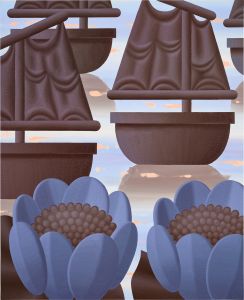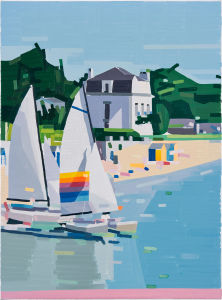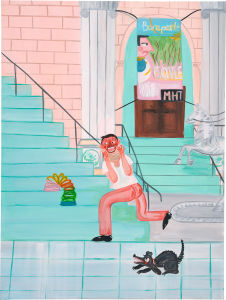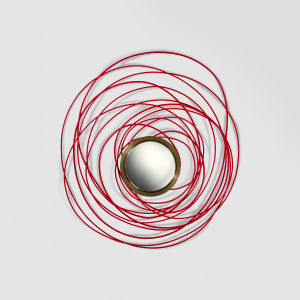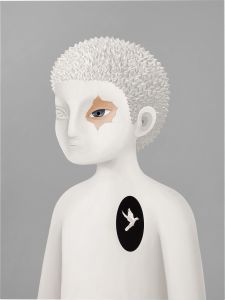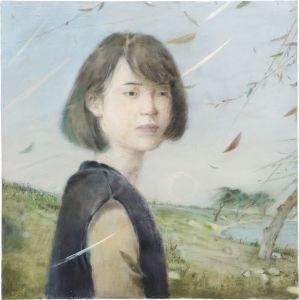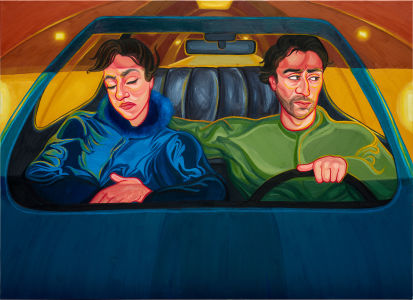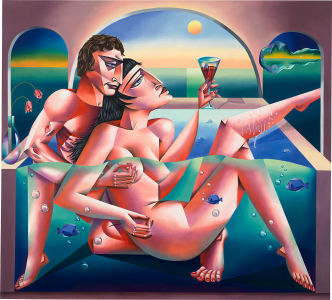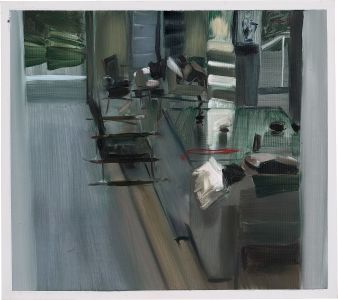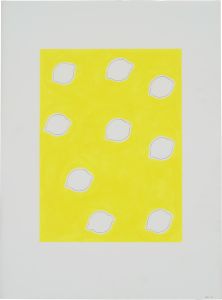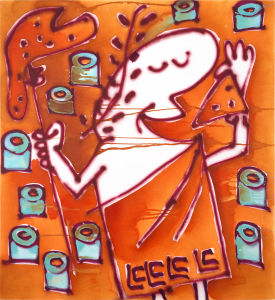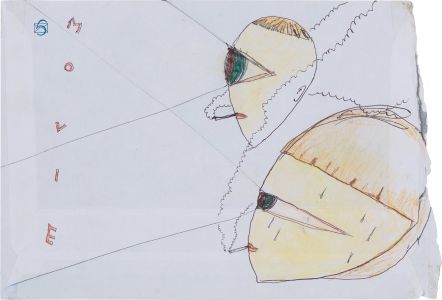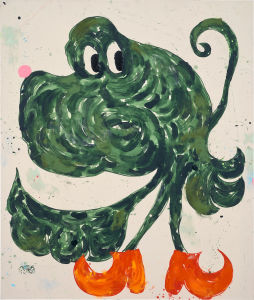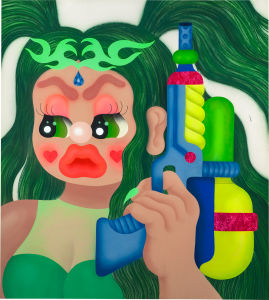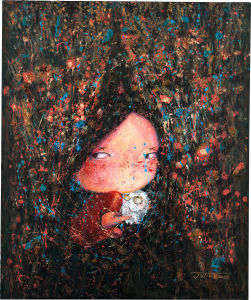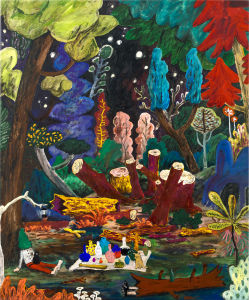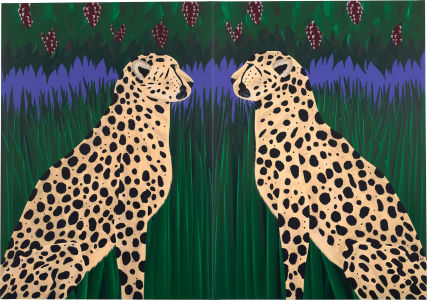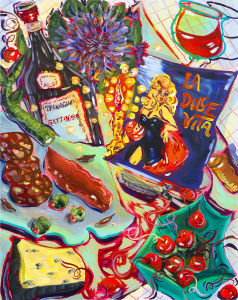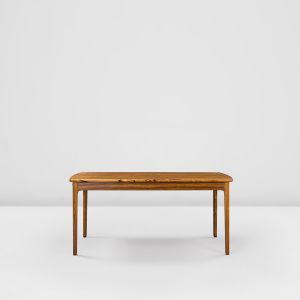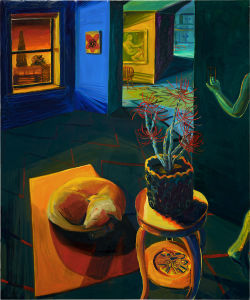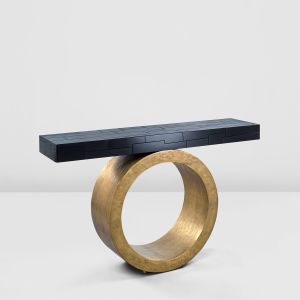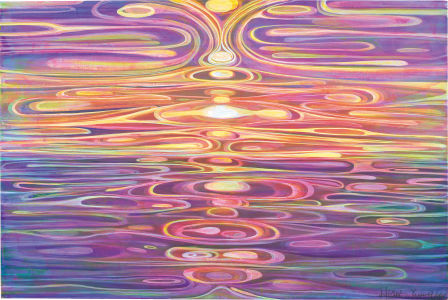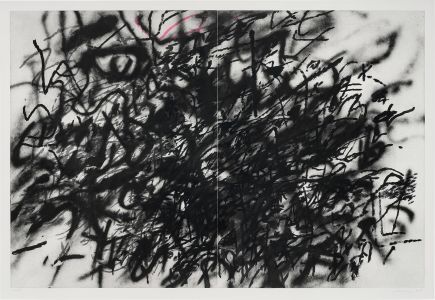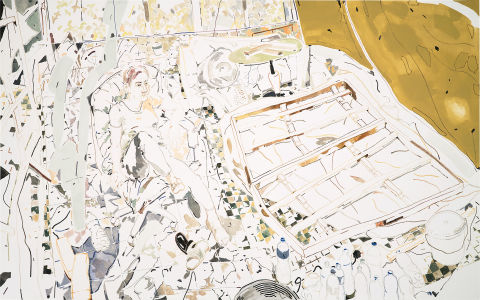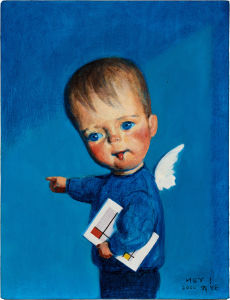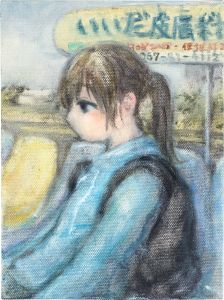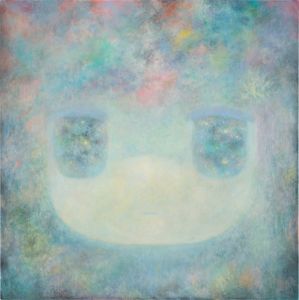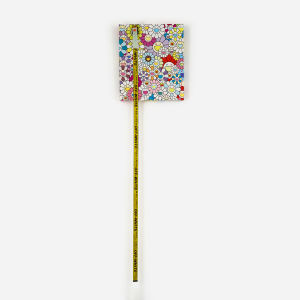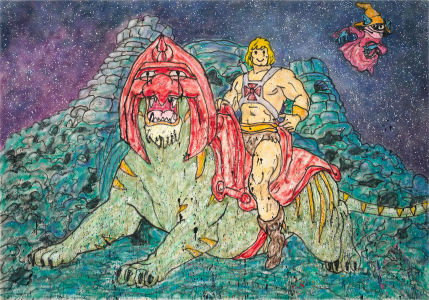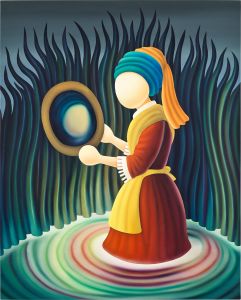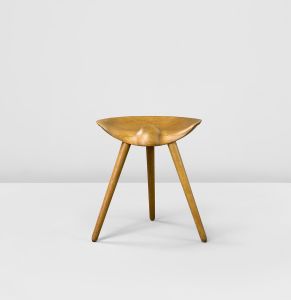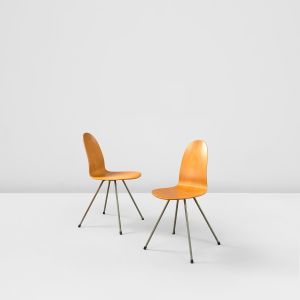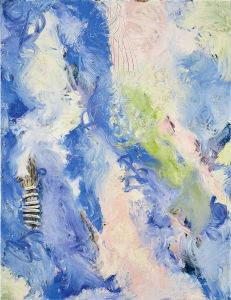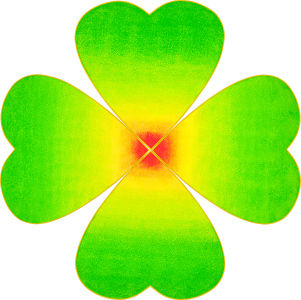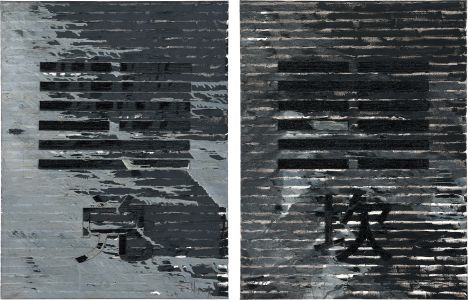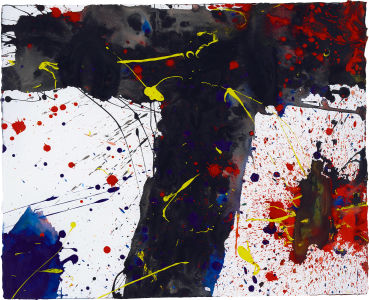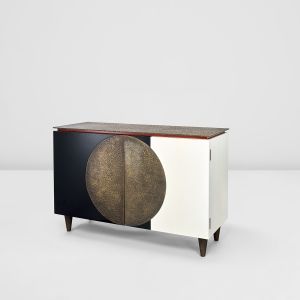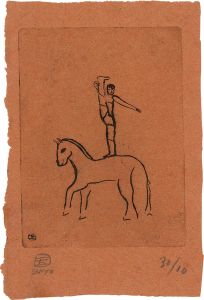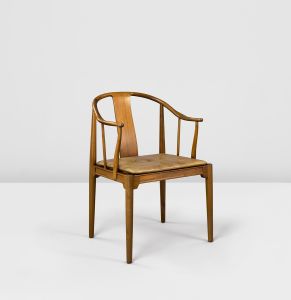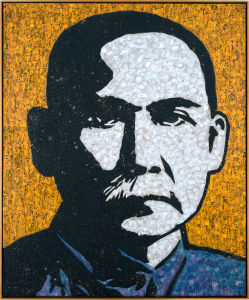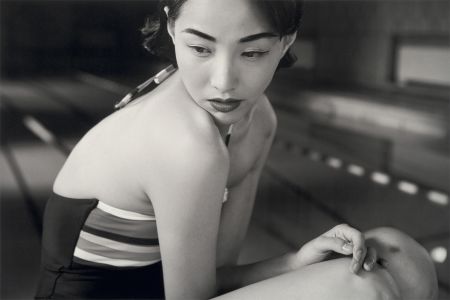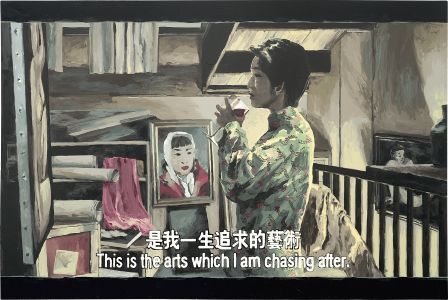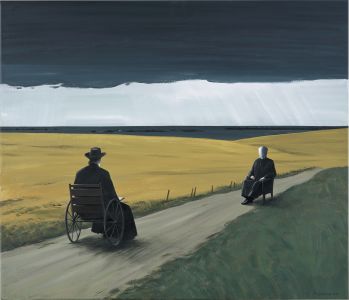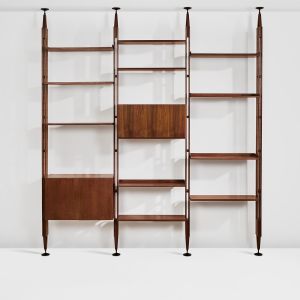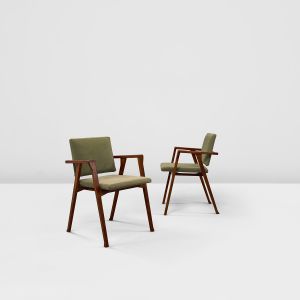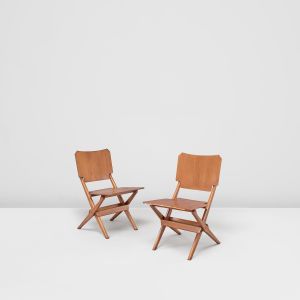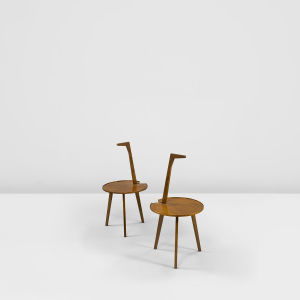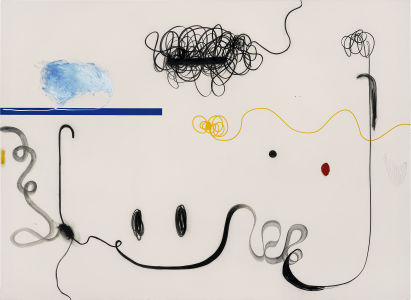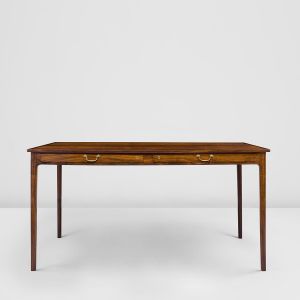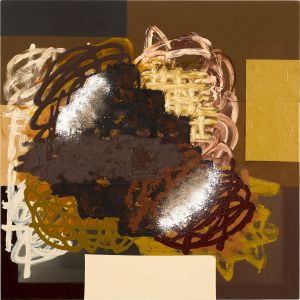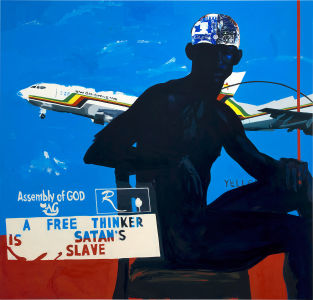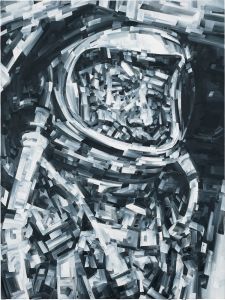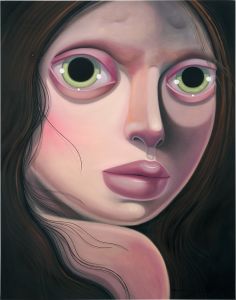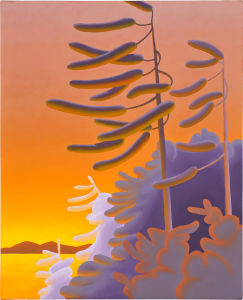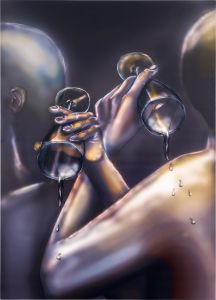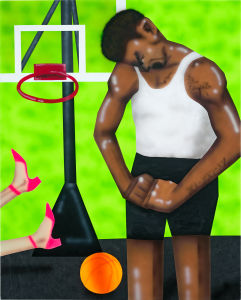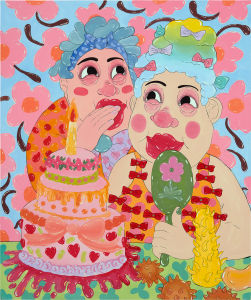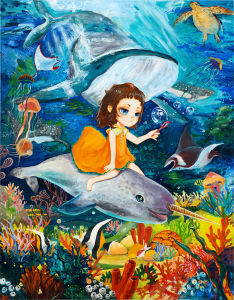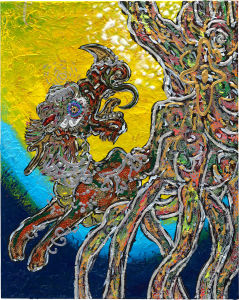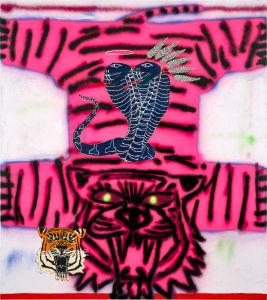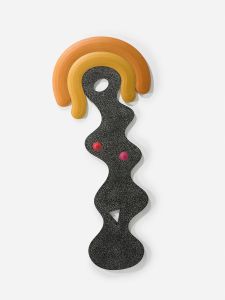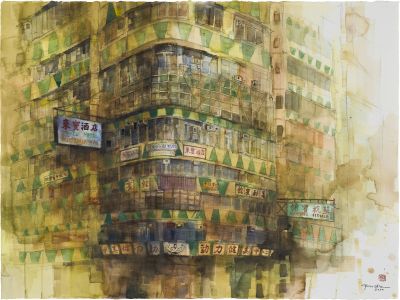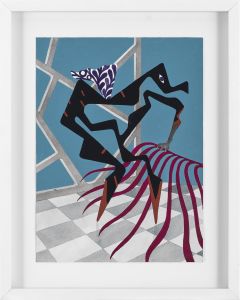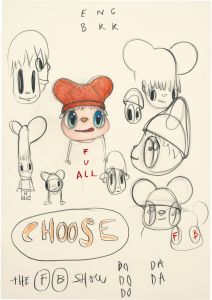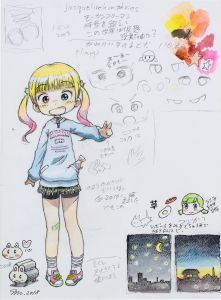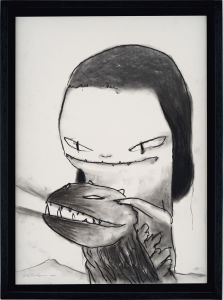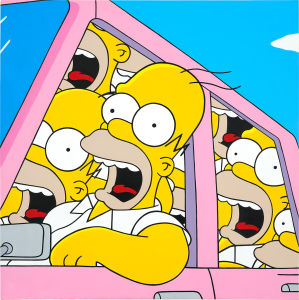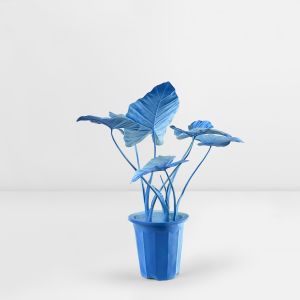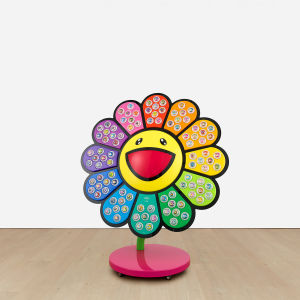“In 2018, I experienced five or six events, including my father’s brain infarction, including a fire, and a series of events that made me feel the impermanence of the world. So my eternal ‘Ruhua’ has two forked eyebrows called Wuchang eyebrows. One stroke is called ‘none’, and the other stroke is called ‘chang’. Actually, it’s a scar, a scar from my real world. This image is actually something that flowed out after I start communicating with myself in 2018.”
— Jia Wei (KK)
The painting Ruhua Wilding · Tussock 01 is part of Jia Wei (KK)’s ‘Ruhua’ series, showcasing the protagonist embracing a vigilant owl amongst luscious vegetation. Injected with a sense of deep introspection, Jia Wei’s work signifies Ruhua’s readiness to embrace her surroundings. The background is a vibrant tapestry of flora, rendered in a variety of colours—reds, blues, greens, and specks of white, suggesting a wild, overgrown garden. This series reflects Jia Wei's personal journey, moving from pain and entanglement to healing and joy. It captures the essence of self-liberation and self-healing as Ruhua meets the world, transforming sadness into playfulness, trust, and celebration.
Jia Wei (KK) is an innovative artist and entrepreneur known for creating the art world of Ruhua and publishing the book Metaverse Power: Creating A New World of Aesthetics. His artistic journey reignited with the advent of the digital era and Web3 technologies. He integrates tools such as digital twins, AR, VR, and AI to create his unique art. His digital art collections, such as Ruhua Garden Thousand Roses and Ruhua Ocean an Increase in Prosperity have achieved remarkable commercial success. Jia Wei’s creations, particularly the Ruhua series, reflect a journey of emotional and artistic exploration, blending his personal narrative with broader themes of healing, self-discovery, and the interaction between technology and art. His work in virtual and digital art forms, alongside his entrepreneurial ventures, positions him as a leading figure at the intersection of art, design, and technology.
Recently, Phillips had the opportunity to speak with Jia Wei (KK) on his vision in creating the world of Ruhua.
Phillips: The world of Ruhua is a testament to your artistic and emotional expression. How do the themes and characters in Ruhua reflect your personal growth and transformation throughout your career?
Jia Wei (KK): In fact, Ruhua depicts my own exploration of life, after past encounters with dark moments led me to reconsider the impermanence of human existence. Art has enabled me to explore a newer immortal world, which in turn allows me to further investigate ways to build a more diversified realm. As a result, I have constructed a TriRealm World, consisting of three selves: the short-lived self in reality, a self that is able to chase the freedom in the immortal world, and a free, pluralistic and varied self in the subworld. That’s why I call it Ruhua Sansheng (Ruhua TriRealm).
Phillips: Can you share the story behind the creation of the Ruhua character? How did you come to formulate this idea, and what does she represent within the narrative of your artwork?
Jia Wei (KK): Ruhua was born out of five disasters I experienced in 2018: my father’s cerebral infarction, my relationship issues, a serious fire in the company that I established, several health problems and other issues. After these unfortunate events, I began to care deeply about my feelings and set off to explore my inner state. Self-reflection led me to find an image in my heart, which turned out to be my true self - a baby without a nose, mouth, and ears, who only possesses a pair of eyes. This true self, which has lived for so many years, can almost be considered eternal. What was most unexpected about this image is her identity of a carefree girl. Despite there being a true self in every one of us, we no longer talk to or understand this part of us as time goes by. Knowing the power of a more eternal life brings me strength and allows for deeper examination of myself. At the same time, it allows me to explore more fantastic unknown worlds.
Phillips: In Ruhua Wilding · Tussock 01, you present a significant moment where Ruhua embraces her heart, symbolized by a vigilant owl, and seems ready to communicate with the world. Could you delve into the emotions and realizations that influenced this particular portrayal, and what message do you hope viewers receive when they witness this embrace between the character and her inner self?
Jia Wei (KK): Ruhua Wilding · Tussock 01 expresses a true dialogue among the ego, id and true self. They normally do not interact with each other much, but they are also eager to host sincere dialogue between themselves. The owl held by Ruhua represents a brand-new and more comfortable self that is achieved in the tussock after immortality is obtained. Since this state in its early stages, it encourages a relationship of mutual understanding rather than forming a close bond. The expressions in Ruhua’s and the owl’s eyes, together with the messy tussock, reflect an inquiry into the essence of life and the authentic self after transcending the id. But they are in a state of symbiosis which has a strong vitality, which encourages exploration of the future, the uncertain and deeper time and space.
Phillips: The vivid use of colour in Ruhua Wilding · Tussock 01 creates a dramatic landscape. What are you trying to convey through the choice of colours and their intensity?
Jia Wei (KK): Ruhua Wilding · Tussock 01 has a distinct colour system, so as to express the most basic and authentic palette from the heart. It doesn’t have too many deconstructions and descriptions of colours in urban areas. Instead, it’s a true expression of tussock, Ruhua, and even the Ruhua who transfigured from an owl. Only in the tussock does the light of life and the quantum power of space shine.
Phillips: In Ruhua Wilding · Tussock 01, the brushwork around Ruhua and the owl is intricate and seems almost frenzied, creating a sharp contrast with the calm expression on her face. How does this use of brushwork contribute to our understanding of the work?
Jia Wei (KK): The tussock expresses time and space, with Ruhua Zaiye (Ruhua Wilding) building a scene where time and space flows. These two elements, together with the mode and life, produce the concept of symbiosis. Therefore, there’s a balance between movement and stillness of life, including the tranquillity of Ruhua and the movement of the tussock, as well as the quietness of Ruhua and the messiness of the tussock. Through this, I also want to build an artistic expression of life beyond time and space.
Phillips: You've utilised AI and digital technologies extensively in creating art. Can you elaborate on how these tools have influenced your creative process and the way you conceive your art pieces?
Jia Wei (KK): In the case of contemporary art, I think it mostly emphasizes ideas backed by content, form and media. Therefore, I regard digital art and even AI art as creative media. Today, digital art and AI art help me express my ideas of immortality and sub-born life in a richer, more pluralistic way. I hope that with the help of these mediums, I can build a fertile world outlook where new artistic languages can be spoken.
Phillips: Your book Metaverse Power: Creating A New World of Aesthetics has made significant waves in the industry. How do you envision the intersection of art and technology evolving in the next decade, and what role do you see for artists in this evolution?
Jia Wei (KK): I think art and technology can be compared with a pair of human feet, as they help lead humans from today’s material world to a higher-dimensional spiritual world. One day, the former may even begin to build a spiritual field of their own. The book Metaverse Power: Creating A New World of Aesthetics tells a story about how individual logic facilitates the digital migration of from the traditional world to the Metaverse. This requires four forces: perception, cognition, creativity and imagination. The integration of these will produce an original force, pushing mankind into a brand-new economy of imagination, in which art is a very important carrier and mode of expression.
Phillips: Your art seems to be constantly evolving, both in medium and message. As we look at your latest works in 2023, how do you feel your current art reflects the changes in the world today, and what do you hope your audience takes away from it?
Jia Wei (KK): In my 2023 works, I have started to explore changes in values and world outlook after exploring human immortality. Once humans gradually achieve eternal consciousness in pursuit of logic of science and technology, original values such as the concepts of life and death, beauty and ugliness, good and evil, big and small, more and less will be subverted. In fact, the series Ruhua Crocodile in 2023 and Ruhua Five Poisonous Creatures reflect a new view of life and death alongside good and evil. I think only when human beings achieve the eternality of consciousness and sub-self can they transcend the limitations of time and space, build a more imaginative self, and become new human beings who better themselves.
Phillips would like to thank Jia Wei (KK) for this interview.


